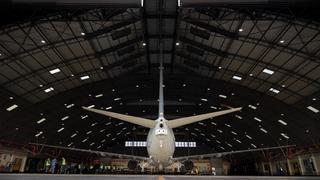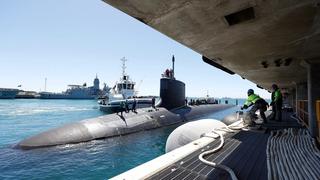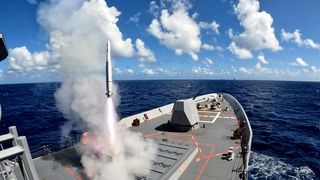About the Defence Industry Roundtable Series
The advent of AUKUS has invigorated longstanding discussions within the Australia-US Alliance about established patterns of cooperation within the bilateral defence industry and technology relationship. Indeed, the success of AUKUS Pillars I and II, as well as that of adjacent initiatives like the Guided Weapons and Explosive Ordinance Enterprise (GWEO), will hinge on the ability of both countries to integrate their defence industrial bases more seamlessly, to share existing technology more readily, and to develop the legal and regulatory frameworks and protections required to innovate together on the next generation of advanced defence capabilities.
To date, these discussions have been confined largely to government-to-government talks, yet the whole-of-nation requirements of AUKUS necessitate other important voices enter the debate. While the role of the private sector in facilitating alliance integration within these vectors is frequently spotlighted, their perspectives across broad-spectrum integration challenges have yet to feature in the public discussion in a way that engenders reciprocal dialogue. Soliciting and considering the views of those who will be tasked with developing and delivering the next generation of advanced defence capabilities through AUKUS and other means has rarely been more important.
This report spotlights points of consensus and divergence within the Australian defence industry community and between Australia and the United States, respectively, on issues central to the realisation of AUKUS.
In 2022, the United States Studies Centre launched a new series of defence industry roundtables, featuring prominent American speakers with deep experience and expertise across the US defence industry, congressional, and government landscapes, and with representatives from across the spectrum of the Australian defence industry landscape invited to attend. In convening this group, the roundtables aimed to explore key issues and obstacles to realising the promise of AUKUS; explore whether there are sufficient incentives for co-innovation and co-production between AUKUS countries; evaluate industries’ risk assessment within this context and determine what industry believes is required to build a trusted defence technology ecosystem bridging national governments and businesses.
Chaired by USSC CEO Dr Michael J. Green and Foreign Policy and Defence Program Director Professor Peter J. Dean, these roundtables were convened to bring the unique ideas, insights, and opinions of defence industry stakeholders to bear on key defence integration issues and to channel these behind the common goal of driving defence industrial integration and technology collaboration to their fullest. The first three engagements focused on the perspectives and experiences of Australian industry with US defence export controls.
The following summary report highlights 15 key findings from these initial discussions. It spotlights points of consensus and divergence within the Australian defence industry community and between Australia and the United States, respectively, on issues central to the realisation of AUKUS and other defence industrial and technology initiatives. It also identifies areas for further alliance collaboration, coordination, and deliberation, and offers suggestions for possible pathways forward on key challenges. We hope that these findings will provide a useful reference point for policymakers and experts dealing with the complexities of defence industrial integration and technology collaboration in the AUKUS and US-Australia alliance contexts.
Key outcomes
1. The imperative of speed
Australian industry stakeholders agree that time is the key variable by which the success of AUKUS will be determined. They are encouraged by the sense of urgency demonstrated by Washington’s speedy approval of retransfer authorities for allied arms to Ukraine and by the timely conclusion of the initial AUKUS nuclear propulsion technology sharing agreement.1
However, while there is mutual recognition between Australia and the United States that the strategic environment has changed, institutional approaches to sharing information and technology between the two allies have not changed to match evolving strategic needs. Australian industry stakeholders agree that the strategic costs of inaction with respect to reforms are unacceptable, but also that these costs are relatively intangible, or simply easy to dismiss, compared with more immediate and more visible international crises or domestic policy priorities. In their view, this has made it more difficult to rouse Washington into channelling focus and resources behind more decisive action on export control reform, the kind that will be essential to enabling seamless and timely collaboration on technology innovation and capability development between the three AUKUS countries.
2. Whole-of-government buy-in
Australian industry stakeholders are concerned that key departments across the US system do not share their sense of urgency regarding export control reform, and are not prioritising efforts to address the specific challenges that have already been identified. Though they are encouraged by the Pentagon’s efforts to align the department behind AUKUS,2 Australian stakeholders are generally pessimistic that other crucial parts of the US system — particularly the Department of State — are moving with the same purpose. Conversely, there are concerns that neither the Departments of State nor Commerce have been engaged by the administration on AUKUS in the same manner as the Department of Defense, despite housing authorities for key export control and licensing frameworks. Unlike in the White House or the Pentagon, there is no single figure vested with the authority to pull together different parts of State or Commerce behind a whole-of-government AUKUS effort. Stakeholders suggested that it would be useful for senior State Department leaders to make clearer statements in public or to Congress, expressing top-level support for the kinds of reforms to US International Traffic in Arms Regulations (ITAR) required for AUKUS to deliver on its promise.
3. The burden of export controls
There is consensus across the Australian defence community that ITAR is the biggest impediment to realising a truly integrated defence industrial and technology enterprise, whether through AUKUS or other mechanisms. In short, disrupting ‘business as usual’ at the State Department’s Directorate of Defense Trade Controls (DDTC) is regarded by Australian stakeholders as a top priority. Australian stakeholders pointed to the problems current ITAR applications pose for routine maintenance and sustainment and noted the extraterritorial nature of these controls ‘taint’ intellectual property produced by allies that enter the US system.3 These disincentives endanger future collaboration on as-yet uninvented technologies or capabilities.
In short, disrupting ‘business as usual’ at the State Department’s Directorate of Defense Trade Controls is regarded by Australian stakeholders as a top priority.
Granted, stakeholders have been impressed by the speed at which Australia, the United Kingdom and the United States reached an agreement on the sharing of American nuclear propulsion technology,4 holding this up as an example of the impact sustained top-level political buy-in can have in a short time. However, Australian industry stakeholders are much more concerned with how ITAR will impact the advanced capabilities under AUKUS Pillar II and the country’s Guided Weapons and Explosive Ordinance (GWEO) enterprise than they are about the fate of the submarine program. Without reforms, they fear collaboration on these capabilities will move too slowly to keep pace with strategic needs. They are also concerned that this sense of urgency is not well understood nor shared by counterparts in the United States.
4. AUKUS: ITAR accelerator or carveout?
Generally speaking, Australian stakeholders see AUKUS as both an accelerator for existing processes in the near term, as well as a tool for achieving systemic reforms to US export control regimes which will fundamentally change the ways these trusted partners do business over the longer term. However, there is less consensus over which effort should be prioritised. Some stakeholders would like to see ITAR ‘discriminate’ in Australia’s favour to fast-track license approvals and technology transfer requests for specific programs. In their present state, US export control systems generally treat top-tier allies like Australia in the same manner as they do countries that are lesser strategic partners, notwithstanding the DDTC’s Open General License (OGL) pilot program (see more next page). Some consider an AUKUS-wide OGL that encompasses the services, actions, and technical data shared between government and industry involved in the development of sovereign capabilities as the best answer to immediate problems.
Others, however, place more emphasis on securing an AUKUS-sized ‘carveout’ in ITAR provisions that would exempt Australia and the United Kingdom from most of these requirements on a rolling basis, but with the inclusion of waivers at the innovation and development stage of collaborative projects to protect Australian and British intellectual property. This group believes a case-by-case approach to addressing ITAR concerns is too incremental to keep pace with evolving strategic needs. They also contend that an acceleration approach alone does not effectively address the wider systemic nature of export control problems. As it stands, intellectual property and export control conditions disincentivise many Australian companies at the leading edge of key emerging technologies from soliciting American input into their product design due to fears of the ITAR ‘taint’ and the risk of losing control over their intellectual property to the US State Department. While minimising or eliminating these concerns through regulatory reform is seen by many in this latter group as essential to the success of AUKUS, they fear that this view is not shared by key constituents within the US system. This observation led some Australian stakeholders to ask: “Does the United States need its allies to innovate, or just to fight?”
This observation led some Australian stakeholders to ask: “Does the United States need its allies to innovate, or just to fight?”
5. Open General Licenses
Stakeholders generally agree that current efforts to grease the wheels of defence industrial and technology cooperation fall short of what is required to realise the full potential of AUKUS. The State Department’s OGL pilot program, intended to fast-track retransfer and re-export authorities for certain defence articles for countries covered under the US National Technology and Industrial Base (NTIB), remedies some issues. In that respect, Australian industry considers these to be useful for some existing programs. However, the parameters for these authorities are highly constrained. From an Australian industry perspective, present OGL conditions greatly limit their value as enablers of defence industrial cooperation, and uptake amongst companies has been rather low as a result. As stipulated by the DDTC, OGLs apply only to the “maintenance, repair, or storage” of unclassified defence articles that do not appear on the US Missile Technology Control Regime (MTCR) Annex or are not identified as missile technologies on the United States Munitions List (USML), such as unmanned systems and precision munitions — both AUKUS priorities under Pillar II.5 Furthermore, OGLs in their present form do not apply to any program designed to develop “new acquisitions or capabilities,” foreclosing their utility as drivers of co-development in the genuine sense of the term.6 Addressing these issues should be a priority for the DDTC come the mechanism’s renewal period in July 2023.
6. ITAR compliance and innovation incentives
Different Australian industrial entities report varying experiences with ITAR depending on their size and capacity to comply with reporting requirements. Specifically, there is a mismatch in perceptions between traditional industry ‘primes’ and smaller innovative companies regarding the desirability or feasibility of dealing with the US Government, with potential consequences for collaborative defence research, innovation, and development. For larger companies, ITAR compliance requirements are viewed as the cost of doing business with the United States. Though the speed of approvals is slower than desired, these requirements are not necessarily perceived as an unduly heavy burden given these companies’ own resident legal expertise or capacity to hire external advice to deal with these obligations. For many small and medium enterprises (SMEs), however, ITAR compliance requirements are a significant financial burden given the costs associated with hiring external legal guidance or attracting and maintaining this expertise in-house. In some cases, including for several companies at the leading edge of key AUKUS technologies, these costs outweigh the potential benefits of entering the US system, and those that do sell into the US system expend considerable resources ensuring their intellectual property avoids being ‘tainted’ by US law. This is particularly consequential for AUKUS, given Australia’s primary innovation contributions will likely be through such SMEs, and there are already indications that many of these companies could become frustrated to the point of opting out of participating in AUKUS projects rather than dealing with onerous export control requirements. Compliance and innovation disincentives also impact the assessments of private equity and venture capital firms, who could demur on investment in emerging defence-related technologies necessary for the success of AUKUS Pillar II.

7. Brain drain in export control and procurement
Australian industry stakeholders generally believe that neither the Australian nor US governments understand each other’s export control and procurement systems as well as they should. This is in large part because both systems suffer from a lack of deeply experienced officials in key implementation roles, with the high turnover rate in these roles due in part to attractive salaries offered to people with this knowledge by the private sector. In the US system, the rapid growth in licensing or transfer requests through ITAR is not being matched with efforts to staff up the offices responsible for processing these requests. Historically, this has led to long delay times for even the most basic unclassified approvals, including Australian requests,7 though State Department spokespersons have recently insisted that Australian and British licensing requests do receive preferential treatment.8 In any case, on the Australian side, constraints are felt most acutely in the observation of stringent compliance requirements. A dearth of government talent with deep knowledge and experience in export control issues means that they are commonly handled by inexperienced public servants without comparable knowledge of the specific legal and regulatory challenges posed by US export controls. Difficulties in retaining deep institutional knowledge have produced the mutual feeling that both governments are “talking past each other” on issues of export control compliance and reform. In lieu of a trilateral AUKUS technology protections framework, one near-term solution could explore secondments of relevant staff from each AUKUS country to one another’s relevant export control authorities, to build institutional knowledge and strengthen ties.
8. Risk culture
The perception amongst Australian stakeholders is that the appetite for risk-taking within the US export controls framework is low. Systemic disincentives such as ramifications for career progression, hefty fines, or even jail time for individuals who improperly administer export controls quash any instinct to fast-track approvals of even unclassified technologies for top-tier allies like Australia and the United Kingdom, even when these are “repeat scripts” — let alone for transfers of the kinds of sensitive technologies that will be critical to the success of AUKUS Pillar II. Together, these factors have produced a risk-averse regulatory culture of “if in doubt, ITAR it.” Such risk aversion is partially to blame for the failures of previous defence industrial integration mechanisms like the Defence Cooperation Treaty and Australia’s addition to the NTIB in 2017. Without a greater appetite or license for risk-taking across these authorities, or the advent of a robust trilateral approval and protections mechanism for AUKUS projects, creative efforts to drive more seamless industrial and technological cooperation between AUKUS partners will continue to run up against these challenges.
The perception amongst Australian stakeholders is that the appetite for risk-taking within the US export controls framework is low.
9. Unilateral information security
There is some disagreement among Australian stakeholders as to the extent to which Australia needs to demonstrate it is sufficiently trustworthy to handle sensitive technical information and intellectual property. To many, the fact that Australia already shares much of its most sensitive intelligence and information with the United States and the United Kingdom through the Five Eyes Arrangement, and that it possesses the capabilities to keep this information safe, casts the wider discussion about trust as somewhat of a red herring, especially in the absence of specific examples of where Australia is ‘leaky.’9 These figures also point to recent reports of advanced US technologies, such as those associated with hypersonic weapons development, being stolen or acquired by adversaries for commercial and military benefit as evidence that it is not only junior allies who need to improve their information and technology protections.10
Conversely, others have pointed to American concerns around information security across the Australian ecosystem as the reason behind US trust concerns, including Australian cyber architecture, digital platform security, security clearance checks, balances for dual nationals and the like. Australia’s Five Eyes membership means that current security protocols are already best in class, but the significant workforce expansion required under the AUKUS Optimal Pathway may require new measures to reassure partners that those standards will remain high.11 Addressing these concerns, ideally in a collaborative and coordinated manner with relevant US and UK authorities, will be crucial to fostering the trust required to share each country’s most valuable military technology secrets.

10. Building a trusted community
Beyond the country-specific information security challenges that the AUKUS partners must address, there is also an emerging discussion about the necessity of a more joined approach to developing the legal, policy, regulatory and technical tools to protect shared technological advantages. There is broad consensus across Australian industry that this will be crucial to developing a trusted defence industrial and technology community between governments and industry entities of the AUKUS countries to support the partnership’s goals. Though this conversation is only in its infancy, there are some encouraging signs that the three countries are beginning to consider these requirements more closely. For AUKUS Pillar II to produce advanced capabilities that are genuinely co-developed and co-owned, the three countries will need to take joint approaches to developing trilateral technology protections in parallel with efforts to jointly produce advanced capabilities and technologies.12 Building a culture of trust into a shared ecosystem of defence technology innovation from the outset will be necessary to get past the current ‘whack-a-mole’ approach to addressing the barriers that inhibit this sort of cooperation. This will also require deepening engagement with defence industry and technology companies to build trust across a cross-government, cross-sectoral axis.
11. Information sharing and supply chains
Information sharing, particularly on shared supply chain data, looms large as a key issue for Australian stakeholders. Mutual supply chain visibility between the United States and Australia would aid conversations about bottlenecks and vulnerabilities in a more distributed and federated industrial base model. However, ‘NOFORN’ restrictions on intelligence and information sharing hamper exchanges on these issues, even in circumstances where such information is largely available in the public realm or already a part of separate alliance discussions. More specifically, governments in all three AUKUS countries are generally reluctant to discuss this issue in meaningful detail, either because of a reluctance to share such sensitive information even within this relatively trusted community, or because this information is unavailable or has not been gathered in critical mass. This is despite the existence of the sorts of information technology capabilities that could help to deliver such a combined picture. Developing administrative frameworks and practical mechanisms for gathering, protecting, and sharing this sort of information between the AUKUS countries will be critical to the development of a genuinely common defence industrial enterprise, especially in the first instance of identifying the most pressing issues or points of weakness.
Information sharing, particularly on shared supply chain data, looms large as a key issue for Australian stakeholders.
12. Incentivising change
Different Australian entities disagree over the best way to incentivise change across the US system. As above, some contend that the Australian Government and industry must do more to demonstrate their trustworthiness to US interlocutors, by developing stronger information protections and revamping vetting processes. They also contend these actors need to refine their own asks of the United States in order to achieve targeted reform or procedural outcomes.13 Conversely, others advocate for a more ambitious approach that seeks to leverage — or even withhold — Australian advantages or US requests to bargain for widespread changes across export control frameworks that would advance Australian equities more quickly and consistently. This could include linking factors outside of the immediate realm of technology, such as US force posture initiatives that leverage Australia’s strategic geography, or US pressure for Australia to add certain overseas commercial actors to its Entities List. Advocates of this approach point to recent international examples of other US partners, like Japan, electing to pursue alternative options for co-developing future defence capabilities — due in large part to similar frustrations with US export controls — as a risk that could manifest in an Australian context without significant reform.14
13. Educating Congress
Roundtable participants generally agreed that an executive order or similar action from the White House is the optimal near-term solution to addressing urgent export control reform priorities. However, they also recognise the key role that Congress can play in driving and shaping AUKUS outcomes. Pleasingly, leading members of the Australia and AUKUS caucuses have publicly stated that ITAR reform for Australia and the United Kingdom is essential to the success of AUKUS.15 Senior leaders on the US House Foreign Affairs Committee and US Senate Foreign Relations Committee have also begun to press for solutions to AUKUS-related export control issues and solutions,16 though these leaders expect congressional reform efforts to “expedite technology sharing arrangements” between AUKUS countries will be “a multi-year process.”17
Furthermore, within Australia concerns remain that AUKUS and the issues at stake beyond the submarine pathway are not as deeply or widely understood by the US Congress as they need to be. Indeed, the initial focus of congressional efforts is nominally on assessing the Pentagon’s approach to processing “arms exports and military sales” to Australia and the United Kingdom, rather than addressing deeper issues around ITAR ‘taint’ and intellectual property that inhibit genuinely trilateral collaboration at the innovation stage of development.18 Although there are some positive signals with respect to greater congressional understanding of AUKUS and export controls, a more sustained effort to educate Congress on the relationship between both AUKUS pillars and export control issues will be required to ensure that congressional statements of support for reform are carried through to implementation and that Australian equities in the scheme of broader reform efforts are well understood.
Within Australia concerns remain that AUKUS and the issues at stake beyond the submarine pathway are not as deeply or widely understood by the US Congress as they need to be.
14. Government-industry relationships
There is a different quality to the relationship between government and industry in Australia compared with the United States. Industry stakeholders in Australia bemoan limitations on their capacity to participate in public strategic debates and what they see as limited opportunities for industry-government strategic policy discussions. They discuss being kept “at arm’s length” from discussions on AUKUS Pillars I and II during the 18-month consultation period, as well as “not being invited into the tent” for crisis simulations that directly implicate national defence industrial capacity and mobilisation issues. They find both instances puzzling given the established view that countries’ defence industrial capabilities often constitute a deterrent in their own right, as well as the need for government-to-government-to-industry engagement to scope, right-size and implement ambitious projects like Australia’s Guided Weapons and Explosive Ordinance (GWEO) enterprise. They contrast this with what they see as a comparatively healthy, organic, and productive industry-government relationship in the United States. Industry participants highlighted the importance of establishing AUKUS industry forums that would allow interactions in confidence between government and industry stakeholders on procedures, requirements, strategic assessments, and industrial and technological inputs going forward.
15. Expanding the discussion
Notwithstanding the focus of this roundtable series on the obstacles to implementing AUKUS Pillars I and II, there was genuine enthusiasm from all participants regarding the potential for AUKUS and adjacent initiatives like GWEO to transform defence industrial and technology cooperation. This was discussed within both an alliance context and with other trusted third parties in ways that would contribute to common economic prosperity, shared deterrence imperatives, and overall regional stability. Participants also saw great value in expanding dialogue between the industry, think tank, state and federal government and university sectors on AUKUS and emerging technologies. Deepening and expanding engagements with and between these stakeholders will be especially critical to the timely and successful implementation of the AUKUS Optimal Pathway.







